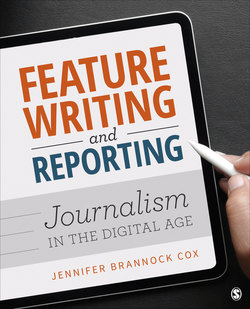Читать книгу Feature Writing and Reporting - Jennifer Brannock Cox - Страница 43
На сайте Литреса книга снята с продажи.
Words With Pros “Casting” for Feature Stories
ОглавлениеInterview with Lane DeGregory, Pulitzer Prize–winning enterprise reporter, Tampa Bay Times
Cherie Diez, Tampa Bay Times
Enterprise reporting has taken Lane DeGregory places most people never go.
During her 30-plus years in journalism, she attended a strip show starring President Donald Trump’s alleged mistress, porn star Stormy Daniels (real name: Stephanie Gregory Clifford). She sat through drug court with a recovering addict. She hung out with carnival workers at the Florida State Fair.
And, most memorably, DeGregory spent six months with the adoptive family of a “feral child” whom police discovered living in utter filth, unable to speak or communicate in any way. This is the journey that led her to write the three-part story “Girl in the Window,” for which she won a Pulitzer Prize in 2009.
In “casting” around for ideas, DeGregory has created her own system for determining whether the subject is worthy of a deep-dive feature story. Using the acronym CAST, she explains what ingredients make up a captivating feature:
Characters. “I want a really strong character. Even if it’s not a person—a place, a town, a building—I want a character, not an idea.”
Action. “I want action. Whether I can follow the action or am able to re-create the action, something has to happen.”
Setting. “Feature stories should have a strong sense of place so they can make the readers feel like they are there.”
Theme. “There has to be some piece of the human condition that people can relate to. Whether it’s fear, rage, hope or even if they can’t imagine themselves in the situation. That’s what I look for when starting to write a story—what’s the one word we can pick out to establish what the theme is?”
Writers should always look for new approaches to storytelling, but DeGregory says their own style, or “voice,” will emerge naturally. Her method for each story is to try to find the subject’s voice rather than her own. She wonders, “What is it like to be that person?”
Although it is hard for her to describe her own voice, she says readers can usually tell when a story is hers without reading the byline.
“I think it’s different for each writer. It’s different for each story. It’s like, when you’re listening to ‘I Want to Hold Your Hand’ and ‘I Am the Walrus,’ the songs are completely different, but you still know it’s the Beatles.”
DeGregory says the key to telling impactful feature stories is to put yourself out there. Feature storytellers need to find something they are interested in to write about. If they’re not interested, they need to find someone who is passionate about the subject to help immerse them in the story.
“You have to be willing to go along for the ride. You can’t report a feature story on your phone. You can’t report a feature story by email. It has to be in person.
“With news, it’s easy to put a shield up, but with features you have to make that human connection. That means sharing a bit of yourself.”
DeGregory hosts a podcast on journalism for the Tampa Bay Times, called WriteLane. She also offers teaching tools for aspiring journalists on her website, www.lanedegregory.org.
